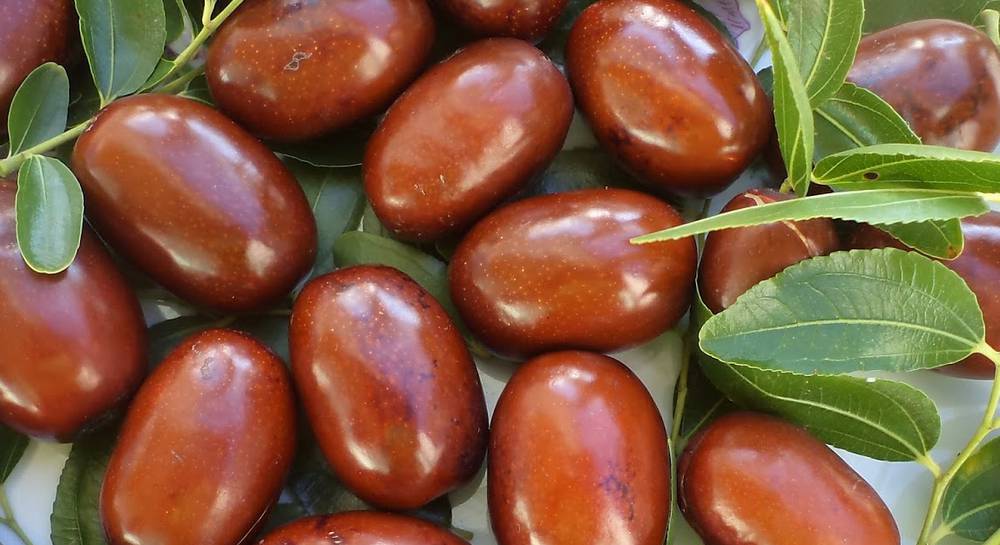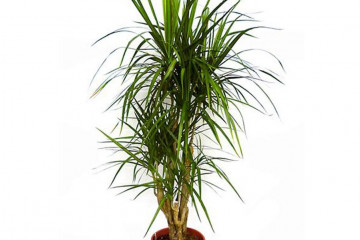Chinese date - how to plant and care for it
Content:
The Chinese date is a popular herb that has medicinal properties. Today, many varieties of this culture are known, each of which has certain characteristics. In order to grow a full-fledged plant at home or on a site, agrotechnical recommendations must be strictly followed.
Chinese date - what kind of plant is it?
This plant is native to China. It is also called red date, ziziphus or unabi. It is a large bush or tree, reaching a height of 8 m. The culture is characterized by a spreading crown and leaves that fall off in the winter.
Wild plant species have large thorns. Moreover, the majority of cultivated plants are devoid of thorns. They have large fruits, reaching 30-40 g. This plant is characterized by many useful properties.
Useful properties and application in medicine
The fruits, foliage, seeds of the plant have long been used in Chinese medicine. The culture has medicinal properties. It is used in such situations:
- high pressure;
- pathology of the digestive system;
- stress;
- respiratory system pathology;
- low hemoglobin;
- heart disease.
The foliage of the Chinese date palm is used for the preparation of medicinal broths or infusions. It contains a special substance - zizifin. It helps to dull the taste buds. Therefore, the substance is very often used for the manufacture of bitter medicines.
Cultivated species and varieties
Today, many varieties of the plant are known, some of them are frost-resistant. Therefore, they can be grown in the middle lane and in regions with cold climates.
The most popular types of Chinese date unabi include the following:
- Koktebel. This variety was obtained in the Nikitsky Botanical Garden. It is distinguished by its late ripening period. The fruits are large in size and covered with dots. The plant is moderately resistant to frost and drought. However, it easily tolerates heat.
- Sinit. This culture was also bred in the Nikitsky Botanical Garden. The berries of the plant taste good.
- Plodivsky. This is a variety of Ukrainian selection. Excellent resistance to drought and low temperatures is considered a key advantage. The fruits are small in size and covered with green-white flesh.
- Yalita. This is a new variety that has many advantages. It was received by the workers of the Nikitsky Botanical Garden. The fruits are early ripening. They are characterized by excellent yields and high-quality fruits.

Today there are different varieties of dates that are suitable for cultivation in different regions.
Growing features
To grow a strong and powerful culture, you must strictly follow the recommendations of specialists.
Place for planting ziziphus
Before planting a plant, it is worth choosing a place correctly. Date needs a sunny area that is reliably protected from the wind. The soil should be light and drained.In heavy soil, it is recommended to add sand and peat. Poor land should be enriched with fertilizers.
Planting unabi in open ground
You can plant a crop in open ground in autumn or spring. At the same time, it is important to correctly select a variety taking into account the climatic characteristics of the region.
When choosing seedlings, it is worth making sure that the shoots and roots are alive. They should not be dry or rotting. It is best to buy plants that have been grown in your region. If the planting material is imported from the southern regions, its winter hardiness decreases.
To plant a date, you should do the following:
- Dig a 50 cm depression.
- Pour a hill of earth at the bottom of the pit, mixing it with rotted compost.
- Place a seedling on a hill and gently spread its roots.
- Special deepening can be omitted. The root collar should be flush with the ground.
- Carefully cover the hole with earth.
- Pour a bucket of water over the culture. In this case, you should use a watering can with a nozzle. It is important to avoid soil erosion.
Pruning methods for different climatic regions
Sanitary pruning involves removing dry and diseased branches. It should be carried out in any region during the warm season. The shaping procedure is performed in the spring. It depends on the growing area.
Unabi does not freeze in the subtropics. For full illumination of the crown, the plant is formed in the form of a vase or bowl. In this case, it is recommended to leave 4 skeletal branches that grow in a circle.
In the northern regions, unabi freezes up to the snow level or up to the root collar. As a result, the culture takes the form of a bush. In this case, it is necessary to thin out the crown so that it does not become too thick.
Chinese date care, basic rules
In order for the plant to develop normally, it needs to be provided with quality care. It should be comprehensive.
In the conditions of the Crimea and other southern regions of Russia, one abundant watering once a month is quite enough for the Chinese date. In this case, the soil should become moist at least 60 cm deep.
Immediately after disembarkation, the young unabi develops slowly, therefore, in the first years of life, it is necessary to weed the area around it. When the bush grows up, the need for such care will disappear.
In early spring, every year, a small tree is fed. For normal development on the surface around the trunk, it will be enough to scatter:
- 1/2 bucket of humus;
- 2 tbsp. spoons of superphosphate;
- 1 tbsp. a spoonful of potash fertilizer;
- 1-2 tablespoons of ammonium nitrate.
How to form a crown
Formative pruning is carried out for seedlings over 2 years old. Usually unabi are grown in the form of a tree with a loose crown. In the second year of growth, the central conductor is cut to 80-90 cm.
The crown is formed in 2 tiers, with branches arranged in a spiral. The distance between the tiers must be the same.
Reproduction of unabi
Dates can be propagated in different ways. For this, seeds, cuttings, shoots are used.
Seed reproduction
You can plant seeds from fully ripe fruits. Moreover, they must be taken from wild small-fruited plant varieties. The seeds of large-fruited crops are distinguished by an underdeveloped embryo, so it is impossible to germinate them.
In late autumn, the seeds from the fruits must be planted in the ground and repaired by 3-4 cm. For the winter, it is recommended to slightly insulate the crops with spruce branches. It must be removed in the spring after the snow melts.
To speed up the emergence of sprouts, cover them with transparent film in the spring. If the seedlings are too thick, it is recommended to thin them out. There should be at least 20 cm between the bushes.
In hot and dry weather, seedlings require watering once a week.1 square meter requires 1 bucket of water. It is advisable to mulch the soil with improvised materials.
Propagation by cuttings
For propagation of the culture, it is permissible to use root cuttings. To do this, you should do the following:
- In early spring, gently rake the soil near the bush and excavate its root 1 cm thick.
- Several cuttings must be made from the selected root. They should be 15 cm long.
- Plant the resulting cuttings horizontally or at a slight slope.
- You need to plant plants on a prepared bed with moist and loose soil. The distance between the cuttings should be 10-15 cm. The planting depth is 5 cm.
- The bed should be moist and loose. After a while, shoots appear from the dormant buds.
- The next spring, the seedlings can be moved to their permanent location.
Undergrowth and layering
Reproduction by root shoots is a fairly simple method that is available to everyone. Small-fruited wild-growing crop varieties form a large number of root shoots. In early spring or early autumn, it is necessary to carefully dig out several offspring and plant them on a permanent site.
Another simple breeding method is the use of layering. In early spring, the lower branches must be bent to the ground and firmly fixed. The fixed part must be sprinkled with soil, and the top must be brought out. If possible, the plant is given an upright position.
The soil above the layers should be moist and loose. The soil must be weeded regularly. In favorable conditions, the cuttings take root during the summer. In the spring of next year, it is permissible to prune the mother branch and move the seedlings to a permanent site.
Features of fruiting and preparation for winter
Fruiting of the culture begins 2 years after planting. The plant is characterized by sweet or sour fruits. They combine a large number of unique ingredients.
Dates contain trace elements, ascorbic acid, ingredients with P-vitamin activity. Thanks to the use of this product, it is possible to normalize pressure and make blood vessels more elastic.
The resistance of a plant to frost depends on its variety. In the early years, all types of culture need to be covered. To do this, you need to spud the planting and cover it with non-woven material. Harboring more mature cultures is very problematic.
Diseases and pests, the fight against them
The main enemy of culture is the unabium fly. Also, sometimes the plant is attacked by spider mites and aphids. To avoid problems, it is necessary to use special insecticidal preparations. But they should be diluted in plenty of water so as not to burn the young shoots.
It is very important to collect all fallen fruits in the fall. It is in them that diseases arise and pests hibernate, which will begin an attack next year.
The unabi date is a popular herb with great health benefits. To achieve success in growing it, you should clearly adhere to agrotechnical recommendations.



















